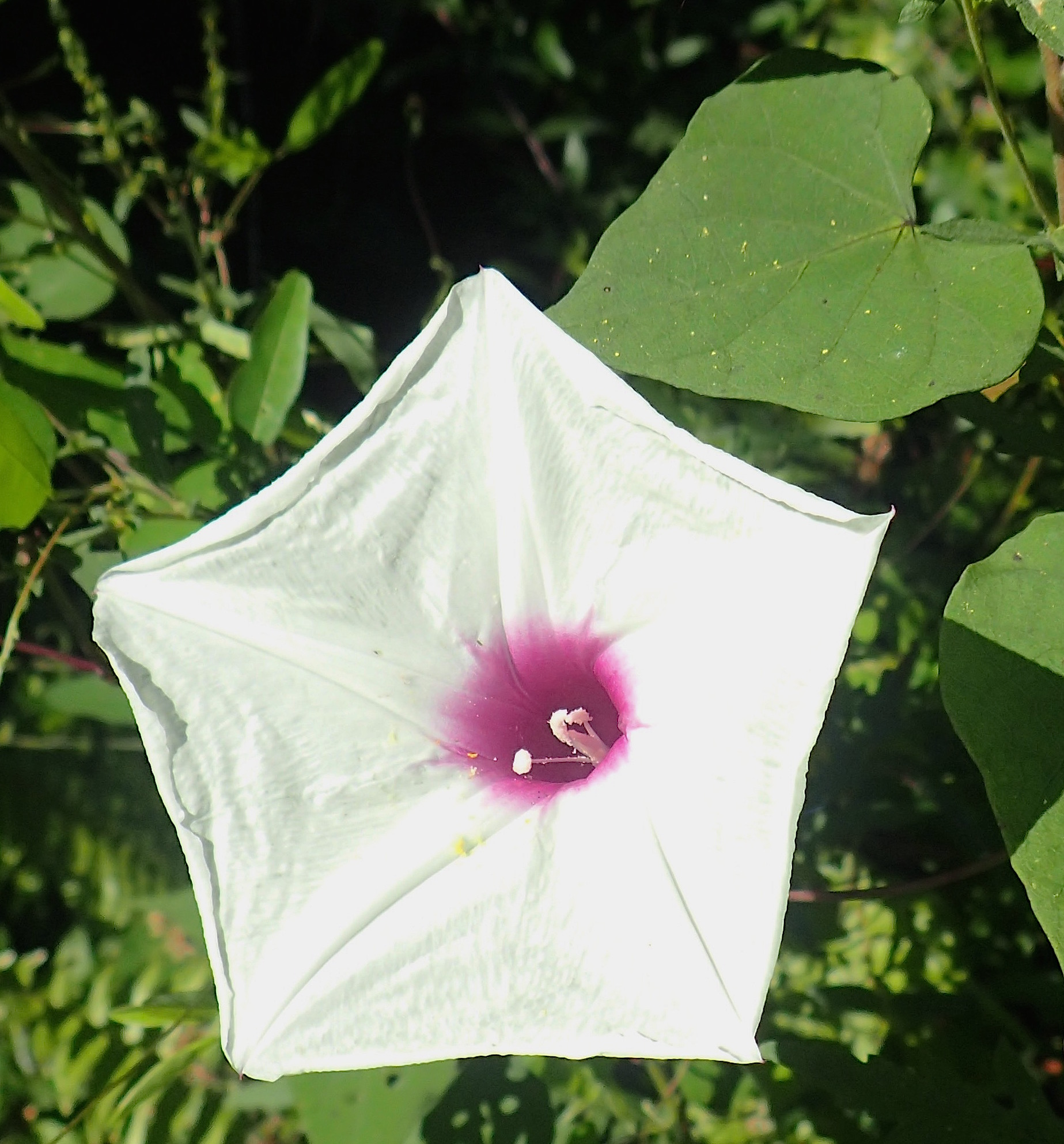
Look for large Morning Glory blossoms that are white or white with ruby throats. Note the heart-shaped leaf of this Old Man’s Leg, Ipomoea panturata. Photo by Green Deane
Do you need to know the botanical names of plants? No. It is far more important to know the plant than to know the name of the plant. Humanity got along for a long time without botanists or nutritionists. Your mother said “this is edible,” and “this is not edible.” That was how information was passed down. Knowing the botanical names can help. But what can be more dangerous is depending too much on common names.
There are, for example, some 18 “pig weeds” in North America, probably more. Some are edible, some are deadly. There are several “Indian Potatoes” which are equally divided among edible and toxic. Indeed, nearly every plant used in some way by humans in North America has been called Indian This or Indian That. Common names can cause problems.
There is, for example, the Stinging Nettle and the Spurge Nettle. I know of at least six people who heard “nettle” and thought the Spurge Nettle was the Stinging Nettle and ate the leaves of the Spurge Nettle, a questionable practice. If you know the two species — or even the two genera — you would never confuse them. They look nothing alike. Names have to be taken with some leeway, even botanical ones. Sometime several botanical wunderkind rename so many plants that botanists can’t be sure they are communicating about the same plant when they use the same name. This was the case a quarter century ago with several North American nightshades. All of this can lead to inaccurate questions that cannot be accurately answered.
I received a nice inquiry recently about eating “wild sweet potato” leaves. This is not a “loaded” question but it is nearly impossible to answer. Cultivated sweet potatoes, Ipomoea batata, are in the greater Morning Glory family. They do have edible leaves. Not great in flavor but edible. But once you move to other species in that family some members have edible leaves and at least one has cyanide in the leaves which is definitely not edible. So the question as asked cannot be safely answered because there’s no hint as to which species is being referred to. I can however, give a little bit of instruction regarding Ipomoeas.
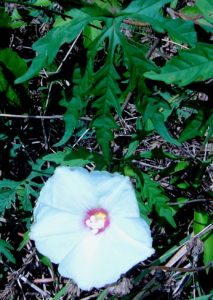
The small incised Alamo Vine, Merremia dissecta, has the right coloring but does not have edible parts. Photo by Green Deane
What I have noticed, generally, is that edibility in this family tends to follow blossom color. So, when I see a blue Morning Glory blossom I ignore it. Usually nothing is edible about the plant though the seeds might be hallucinogenic. If I see a pink Morning Glory blossom it can go either way, usually not edible, but sometimes a famine food, same with a red blossom. If I see a small white Morning Glory blossom I ignore it. A local one, the Alamo Vine, has cyanide. But if I see a large white Morning Glory blossom or a large white Morning Glory blossom with a ruby throat I investigate it. Usually something is edible about the plant. It might be the blossom, leaves, root, or the entire plant depending on the species. For this discussion I would consider two inches across the petals and under small. Large is often three inches across and four to six inches long. With this rough guide you can from a distance glance at a Morning Glory blossom and know whether to look further. To read more about Morning Glories go here.
As a reminder we are in prime persimmon season. If your local persimmon is not ripe enough to eat now it will be within days. I have found trees with both ripe persimmons and trees with persimmons not quite ripe but edible. Mid-October is exactly when to be looking for them. You can also spot them from the highway though usually they are not edible because of the highway. Friday I was driving from Tampa to Orlando and just northeast of Armstrong High School before the interstate weighing station there was a persimmon heavy with ripe orange fruit, and nearly no leaves. Persimmons are among the first to loses leaves in the fall. It was strikingly easy to see at the boundary fence even going 70 mph. (Persimmons grow on the edges of things, transition zones.) While it was uphill from the interstate it is also on the mostly downwind side which could influence how tainted the fruit is. It makes pollution personal. Read about Persimmons here.
While out and about locally it is also an easy time to identify “Yam A” which is the biggest caloric payoff in Florida. There are actually some 10 species of “yams” in Florida if not more. And they are the true yams, not varieties of sweet potatoes (Ipomoeas) which are improperly called “yams” and sold in cans and in grocery stores. The true yam you want to be looking for is Dioscorea alata. We are interested not in eating its “air potatoes” but using them to identify the vine. The plant’s root can grow to many pounds — 30 or more — is right below the surface usually, and is used like potatoes. On my website it is called Yam A. It has dark brown, misshapen “air potatoes.” They are shaped like a Y an L, a candle or a pile of dog manure. They are quite visible this time of year hanging on the vine and make finding the root easy. You can read more about them here.
Upcoming foraging classes:
Sunday, October 23rd, Dreher Park, 1200 Southern Blvd., West Palm Beach, 33405. 9 a.m. Meet just north of the science center.
Sunday, October 3oth, Wickham Park: 2500 Parkway Drive, Melbourne, FL 32935-2335. 9 a.m. Meet at the dog park inside the park.
Sunday, November 6th, Red Bug Slough Preserve, 5200 Beneva Road, Sarasota, FL, 34233. 9 a.m.
Sunday, November 13th, Spruce Creek Park, 6250 Ridgewood Ave. Port Orange, 32127. 9 a.m. This is just south of Daytona Beach. Meet at the pavilion.
Sunday, November 20th, John Chestnut County Park: 2200 East Lake Road, Palm Harbor, FL 34685. 9 a.m. Meet at the beginning of the Peggy Park Trail inside John Chestnut Park.
Sunday, November 27th, Blanchard Park, 10501 Jay Blanchard Trail, Orlando, FL 32817. Meet by the tennis courts next to the YMCA.
Sunday, December 4th, Bayshore Live Oak Park, 2200 East Lake Road, Port Charlotte. 9 a.m. We meet by the parking lot near the intersection with Ganyard Road.
To learn more about the classes go here.
Want to identify a plant? Looking for a foraging reference? Do you have a UFO, an Unidentified Flowering Object you want identified? On the Green Deane Forum we chat about foraging all year. And it’s not just about warm-weather plants or just North American flora. Many nations around the world share common weeds so there’s a lot to talk about. There’s also more than weeds. The reference section has information for foraging around the world. There are also articles on food preservation, and forgotten skills from making bows to fermenting food. You can join the forum by clicking on the button on the upper right hand side of this page.
All of Green Deane’s videos are available for free on You Tube. They do have ads on them so every time you watch a Green Deane video I get a quarter of one cent. Four views, one cent. Not exactly a large money-maker but it helps pays for the newsletter. If you want to see the videos without ads and some in slightly better quality you can order the DVD set. It is nine DVDs with 15 videos on each. Many people want their own copy of the videos or they have a slow service and its easier to order then to watch them on-line. They make a good gift for that forager you know. Individual DVDs can also be ordered. You can order them by clicking on the button on the top right of this page or you can go here.
Some of you may or may not know but EatTheWeeds also has a facebook page. Over there Jeff Mors and Mallory Chaplin have been doing a lot of work with our in-season acorns. This includes harvesting, leaching, grinding the meal and making bread. Jeff also posted his recipe. There are many ways to process acorns and the quality of acorn can also vary greatly. The amount of tannic acid in the acorns determines how much work will be involved processing them (as does size. Big acorns give more food for the work.) Don’t forget any worm or grub you find in the acorn is edible. If you want to read more about acorns go here.
This is Newsletter 229.
If you would like to donate to Eat The Weeds please click here.

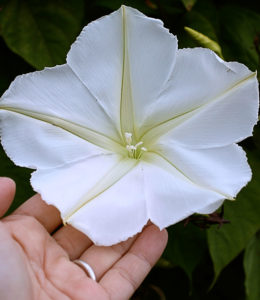
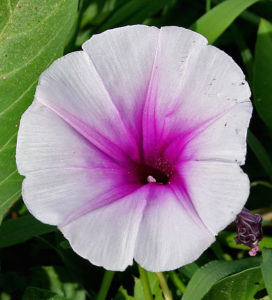
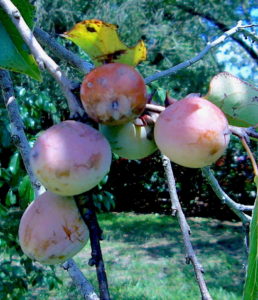
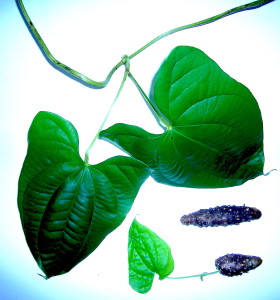
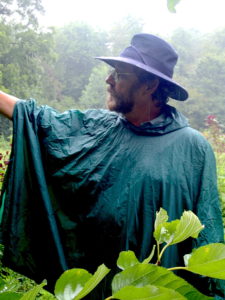

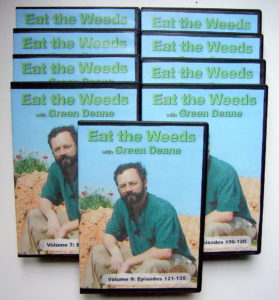
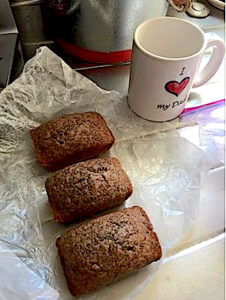

I am wondering about what is called “Queen Anne’s Lace” here.
It looks like a wild carrot, and the root is carrot looking, but pale.
I have heard both ways that its poison and its edible, root wise.
(My mother always claimed it was poison, and don’t eat it). It grows wild all over here in Western WA.
Thanks!
I have articles in the main website about them and the differences. Queen Anne’s Lace is not toxic per se… some folks might have an allergy to it.
Glad to see the newsletter, I have so many bombarding me that I miss these. Like the Yam photo, and the persimmon tree photo. Thanks.
About “Bambi” – vernacular for Sweet potatoe or Ipomoea batatas, particularly on its situation in Sudan, I’d rather refer to our famous great scientist and previous agricultural minister Ahmed A. Geneif. Please google( Improvement of Sweet Potato (Ipomoea Batatas) in East Africa,…
https://books.google.com>books
In this report which was a long time ago: Cultivers of orange flesh were introduced earlier and evaluated and some showed high yields. Recently some introductions from ITTA showed very high yields compared to local cultivers in the South. Future research priorities will emphasize on:
_ Introduction and improvement of cultivar.
_Improving cultural practices. _Surveying pests and diseases and developing methods of control.
_Exploring new utilization of the crop.
I must add that, unfortunately, in our developing countries many research results are “gone with the wind”.
On edibility, I. like most of my people, I eat the tuber cooked, or boiled;but I prefer it roasted.
Is there anyone out there that is willing to send me a few of the “air potatoes” from Dioscorea alata? I am willing to pay shipping and handling cost.
I have Yam B growing and it can certainly grow more that 15 feet in a year.
I have worked in the gas and oil industry in west Africa where they grow an eat a lot of yams. I have eaten several dishes made with yams and my favorite is call African Scramble in Nigeria. But fufu (pounded yams or swallow food) is their favorite, but I am not fond of it. I would like to grow the Yam A for cooking.
Contact me at mikemc@embarqmail.com
Thanks in advance for any help in this matter.
Michael